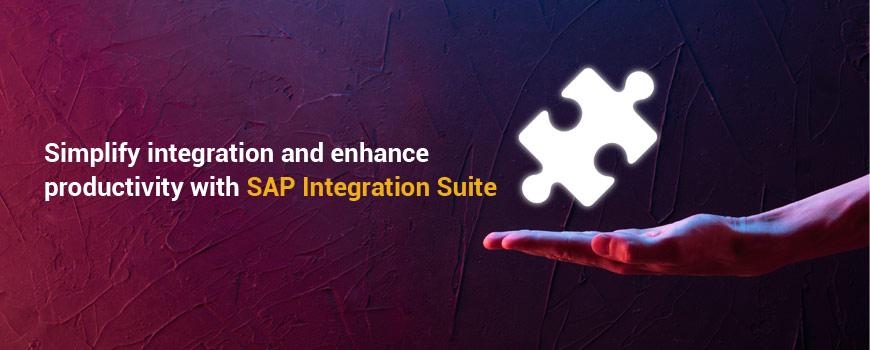Simplify integration and enhance productivity with SAP Integration Suite
14 June 2023


Girish Siruvani
Director- Technology and Enterprise ArchitectureGirish Siruvani, Director of Technology and Enterprise Architecture at Applexus, is a seasoned expert in SAP, Web Technologies, GCP, and DevOps. With a strong track record...

Shoukat Ali
Manager- Integration DeliveryShoukat Ali holds the position of Manager of Integration at Applexus Technologies, bringing extensive expertise in the field of integration. Shoukat has over 11 years of...
In a world where data reigns, businesses face a common challenge—fragmented systems and disconnected information. These hurdles hinder collaboration, introduce inefficiencies, and impede growth. Imagine a global manufacturing giant, struggling with disparate systems that obscure their operational insights. Or an e-commerce company, struggling with the daunting task of reconciling data from various sources in real-time. Whether it's a healthcare organization struggling to bridge information silos or a financial institution wrestling with data fragmentation across its systems, the road to seamless integration is riddled with obstacles. These integration hurdles are unique to each industry, hindering collaboration and growth.
Fortunately, in the face of these integration challenges, businesses can turn to robust middleware solutions like SAP Integration Suite(SAP IS). It has evolved from SAP XI, advancing through SAP PI, SAP PO, SAP CPI, and now emerging as SAP IS, a comprehensive iPaaS (Integration Platform as a Service) solution. SAP Integration Suite serves as a vital bridge that enables the sharing of data and services among two or more applications. By leveraging the capabilities of SAP Integration Suite, businesses can effortlessly integrate their existing SAP and non-SAP systems with new ones, eliminating the need for expensive custom solutions from scratch. From seamless data exchange and real-time insights to enhanced collaboration and agility, SAP Integration Suite offers a powerful toolkit to tackle integration complexities head-on.
Forrester Consulting interviewed integration experts and enterprise architects across five companies with annual revenues surpassing $27 billion. These customer interviews enabled Forrester to build a composite point of view that demonstrated a return on investment approaching 300% with benefits exceeding $2 million in the first three years. - SAP[1]
Features of SAP Integration Suite

- Robust functionality: SAP Integration Suite offers a set of functionalities that enable businesses to integrate and manage critical processes across SAP and third-party applications. With features like 99.95% uptime, multizone availability, failover prevention, and elastic scaling, organizations can deliver high performance and throughput even in complex and distributed landscapes.
- Innovation with modular functionalities: With capabilities for composability, real-time event management, and API management, businesses can easily adapt and respond to changing market demands. The centralized hub allows users to access over 3,600 APIs from SAP and its partners, facilitating collaboration and accelerating innovation.
- Prebuilt integrations and connectors: SAP Integration Suite offers a vast library of over 3,000 prebuilt integrations and connectors for both SAP and third-party solutions. By leveraging these prebuilt components, businesses can expedite connectivity, reduce complexity, and achieve superior time-to-value. They can focus more on addressing their specific business needs rather than building integrations from scratch.
- Data semantics and business context: By incorporating data semantics, organizations can ensure that data is correctly interpreted and exchanged, enabling seamless communication between systems. It utilizes the power of data semantics in the SAP One Domain Model, which defines standardized business objects such as products, customers, and orders. This enables developers to grasp the business context in which these objects are utilized.
- SAP Business Accelerator Hub: This platform provides a centralized hub for organizations to discover, explore, and access a wide range of prebuilt integration content and templates. By leveraging the content and expertise available on the SAP Business Accelerator Hub, organizations can accelerate their integration efforts, enhance efficiency, and ensure successful implementation.
Components of SAP Integration Suite
The components of the SAP Integration Suite provide businesses with a wide range of tools and capabilities to overcome the complex challenges of integration. Let's delve deeper into each of these components and explore how they contribute to a seamless and efficient integration process.
Tent isolation & Data separationAuditing & loggingIntegration AssessmentCloud integrationOpen connectorsEvent meshIntegration AdvisorTrading partner managementAPI managementCreated by popcornartsfrom the Noun ProjectTransport level securityMessage level securityIdentity & Access managementData protection & privacyTent isolation & Data separationAuditing & logging
Integration Assessment: The Integration Assessment capability within SAP Integration Suite offers a structured and guided approach to designing and executing your enterprise integration strategy. At its core, this capability is built on the SAP Integration Solution Advisory Methodology (SAP-ISM), which streamlines the integration process. It provides a range of powerful tools to support various tasks, including:
- Integration recommendations: Leverage the latest SAP integration technology recommendations to ensure that the integration approach is aligned with industry best practices.
- Integration documentation: Document your integration landscape and technology strategy to enhance communication between project teams and system integrators.
- Accelerate integration: React faster to new interface requests or change requests by leveraging the tools and resources provided within the Integration Assessment capability.
- Integration differentiator: By embracing a systematic and strategic approach to integration, businesses can gain a competitive edge, drive innovation, and deliver enhanced value to customers.
Cloud integration: The Cloud Integration capability empowers organizations to build and execute integration flows between applications, whether they are on-premise, in the cloud, or across hybrid landscapes. It supports various integration scenarios, including application-to-application (A2A), business-to-business (B2B), and business-to-government (B2G) integration.
- Prebuilt integrations: The library of 2,600 prebuilt integrations simplifies the process of connecting SAP systems with third-party applications and data sources, enabling faster and more streamlined integration.
- Intuitive AI-assisted web interface: The Cloud Integration capability allows users to design and manage integration flows with ease, reducing the complexity associated with integration development.
- SAP process orchestration: This integration ensures a smooth connection between cloud-based integration flows and on-premises systems, enabling end-to-end process integration across your enterprise landscape.
Open connectors: The Open Connectors capability of SAP Integration Suite offers a simplified and streamlined approach, connecting over 170 third-party applications and solutions. It spans various domains such as collaboration, messaging, CRM, help desk, and more.
- Prebuilt connectors: Open Connectors provides a rich library of prebuilt connectors that enable organizations to simplify, standardize, and accelerate connectivity with third-party cloud applications.
- RESTful APIs and JSON: Open Connectors supports RESTful APIs and JSON, allowing organizations to leverage open data formats, ensuring compatibility and interoperability with different third-party service architectures.
- Data field transformation: With Open Connectors, organizations can apply common resource definitions from one or more third-party applications into a normalized form, standardizing data fields and structures.
- Bulk data support: Open Connectors supports efficient handling of bulk data by enabling the upload and download of data in a normalized manner, regardless of the underlying service architecture.
API management: The API management capability empowers organizations to create seamless, connected digital experiences for their customers, partners, and employees. By exposing processes and data as APIs through an enterprise API portal, businesses can unlock new opportunities and tap into the potential of the API economy.
- Design your APIs: With API management, organizations can design their APIs based on open standards such as OData and the OpenAPI Specification.
- Develop your APIs: API Management allows businesses to develop APIs by exposing and composing back-end interfaces from various applications or middleware.
- Protect your APIs: Organizations can safeguard their APIs from security threats, manage traffic effectively, and leverage over 40 built-in policies to enforce security measures and control access to sensitive data.
- Monitor APIs: API Management offers advanced monitoring capabilities that enable organizations to track API usage patterns, analyze performance metrics, and identify and resolve any issues or bottlenecks in real time.
- API portals: API Management provides API portals for organizations to engage with developers, provide comprehensive documentation, and offer self-service capabilities.
Event mesh enhanced capability: The event mesh enhanced capability enables organizations to establish asynchronous, real-time communication between applications across distributed landscapes. This fully managed cloud service supports event-driven architectures, allowing businesses to adopt scalable event-driven process integration patterns and handle peak loads seamlessly in any environment.
- Manage, monitor, and visualize decentralized event streaming: Organizations can efficiently manage, monitor, and visualize event streaming activities across distributed landscapes.
- Native response to business events: The Event Mesh capability allows organizations to natively respond to business events originating from core SAP solutions like SAP S/4HANA and SAP SuccessFactors, as well as third-party sources.
- Publish and subscribe to business events: Event Mesh enables seamless integration and event-driven data exchange across hybrid, multi-cloud, and edge environments, facilitating real-time collaboration and data synchronization across diverse systems.
- Fully managed cloud service: The Event Mesh capability is delivered as a fully managed cloud service, providing organizations with a reliable and scalable infrastructure for their event-driven architectures.
- Connecting SAP and non-SAP systems: Event Mesh enables seamless connectivity between SAP and non-SAP systems, ensuring interoperability and smooth data exchange across heterogeneous landscapes.
- Enabling a network of brokers: Event Mesh facilitates the establishment of a network of brokers, enabling efficient routing and distribution of events across multiple systems and environments.
- Out-of-the-box support for SAP event sources: Event Mesh provides out-of-the-box support for SAP event sources, making it easier for organizations to integrate and leverage events generated by SAP solutions seamlessly.
- Event management and monitoring: With Event Mesh, organizations can track, analyze, and gain insights into event data, ensuring visibility into event processing, and identifying bottlenecks.
- Event design, publishing, and discovery: Event Mesh enables organizations to design, publish, and discover events within their event-driven ecosystem, facilitating seamless event integration and collaboration.
- Event API products and automatic AsyncAPI code generation: With Event Mesh, organizations can create event API products and leverage automatic AsyncAPI code generation.
- Cross-cloud, on-premises, and edge deployments: Event Mesh supports deployments across various environments, including cross-cloud, on-premises, and edge deployments.
- Transaction support: Event Mesh provides transaction support, ensuring consistency and reliability in event processing, enabling organizations to maintain data integrity across distributed systems.
- Event replay: Event Mesh enables event replay, allowing organizations to replay past events for testing, troubleshooting, or auditing purposes, enhancing data traceability and historical event data analysis.
Integration Advisor: The Integration Advisor capability of SAP Integration Suite leverages a crowdsourced machine learning approach to address the most significant challenges faced in B2B, A2A, and B2G integration scenarios. It provides intelligent solutions and recommendations to simplify the complex task of mapping data structures between source and target systems.
- Standard message formats: Integration Advisor supports multiple business partners using different industry-standard message formats, eliminating the need for custom mapping for each partner.
- Standard message type definitions: With Integration Advisor, organizations can start with these predefined templates and customize them as per their specific requirements, saving valuable time and effort.
- Message implementation: Integration Advisor allows organizations to define and document source and target message implementation guidelines based on industry and geographic context.
- Message mapping: Integration Advisor provides intelligent mapping proposals, reducing manual effort and minimizing errors in complex data mapping tasks.
Trading partner management: The Trading Partner Management capability of SAP Integration Suite enables organizations to efficiently handle B2B integrations, particularly in the context of Electronic Data Interchange (EDI). It allows businesses to create and maintain trading partner profiles, taking into account their unique B2B requirements.
- Partner management: Trading Partner Management provides a centralized platform to streamline partner-related activities, ensuring seamless collaboration and efficient communication.
- Onboarding partners: Trading Partner Management facilitates quick and hassle-free partner onboarding, reducing time-to-value and enabling faster collaboration with new business partners.
- Partner agreements: With Trading Partner Management, businesses can easily create and manage partner agreements, ensuring alignment and clarity in B2B interactions.
- Monitor partners: Trading Partner Management provides monitoring capabilities, allowing organizations to gain insights into integration activities with their trading partners, ensuring compliance with agreed-upon service levels.
- Exchange data with partners: Trading Partner Management facilitates data exchange with trading partners by leveraging the capabilities of Integration Advisor and Cloud Integration, ensuring smooth data flows and effective collaboration.
Security Aspects of SAP Integration Suite
The Security Aspects of the SAP Integration Suite prioritize adherence to internal policies, including technical policies, procedures, directives, guidelines, and product standards. Employees and operators adhere to the SAP code of conduct and behavioral security standards. Secure software development is ensured through the SAP Secure Development Lifecycle (SDLC), incorporating measures like test-driven development and threat modeling. Additionally, the suite undergoes rigorous certifications to comply with industry standards and requirements.

- Transport level security: Integration Suite supports secure protocols like HTTPS, SFTP, SMTP, POP3, and IMAP for secure data transmission, ensuring the confidentiality and integrity of data during transit.
Message level security: Integration Suite provides secure communication through encryption and digital signatures, ensuring the confidentiality and integrity of exchanged messages throughout the communication process.
Standard
Security Feature
PKCS#7/CMS Enveloped Data and Signed Data
Encryption/decryption of message content
Signing/verification of payload
PKCS#7/CMS Enveloped and Signed Data
Encryption/decryption and signing/verification of payload
Open Pretty Good Privacy (PGP)
Encryption/decryption of message content
Encryption/decryption and signing/verification of message
XML Signature
Signing/verification of payload
WS-Security
Signing/verification of SOAP body
- Identity and access management: The platform employs robust identity and access management, authenticating users through an identity provider like SAP ID Service, and granting role-based access to specific functions.
- Data protection and privacy: Encryption techniques are employed to secure data at rest and during transmission, protecting against unauthorized access and maintaining data confidentiality.
- Tenant isolation and data separation: Integration Suite ensures the strict separation of customer data through a concept called tenant isolation, preventing cross-contamination.
- Auditing and logging: The platform provides robust auditing and logging capabilities to track activities performed on integration artifacts including creating, editing, deleting, or deploying tasks.
In the era of interconnectivity, integration is no longer a mere necessity but a strategic differentiator. As businesses strive to connect diverse systems, applications, and data sources, SAP Integration Suite stands tall as a trusted companion. SAP Integration Suite is not just about integration— It's about accelerating business processes, adapting to changing market dynamics, and staying ahead of the competition.
Applexus has successfully implemented various integration projects, solving real-world challenges for its clients. Let's explore some of these use cases, showcasing how Applexus leveraged SAP Integration Suite to drive efficiency and enhance business processes.
- Applexus Improves Workflow Efficiency with Conexiom and SAP ECC Integration
- Applexus Prevents Incorrect Fill Records with InLabel and SAP ECC Integration
- Applexus Maximizes Maintenance Productivity with Prometheus and SAP Cloud Integration
- Applexus Improves Driver and Planner Experience with SAP Cloud Integration
Conclusion
Building upon the presented use cases, it becomes evident that SAP integration, in collaboration with Applexus, delivers substantial advantages to businesses. This powerful collaboration empowers businesses to drive efficiency, boost productivity, and realize their full potential in the dynamic digital landscape. So, let the barriers crumble, the silos dissolve, and the possibilities expand. It's time to connect, collaborate, and conquer the digital realm where integration becomes your greatest strength.
1 By Christopher Aron, May 15, 2022. Integration Study Informs of Payback within Six Months, SAP. https://blogs.sap.com/2022/03/15/integration-study-informs-of-payback-within-six-months








